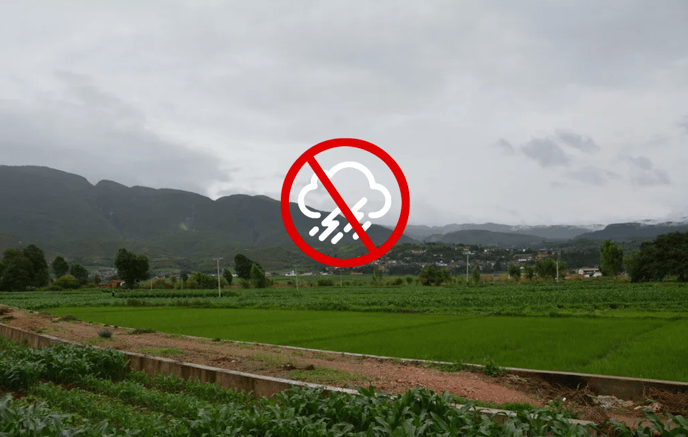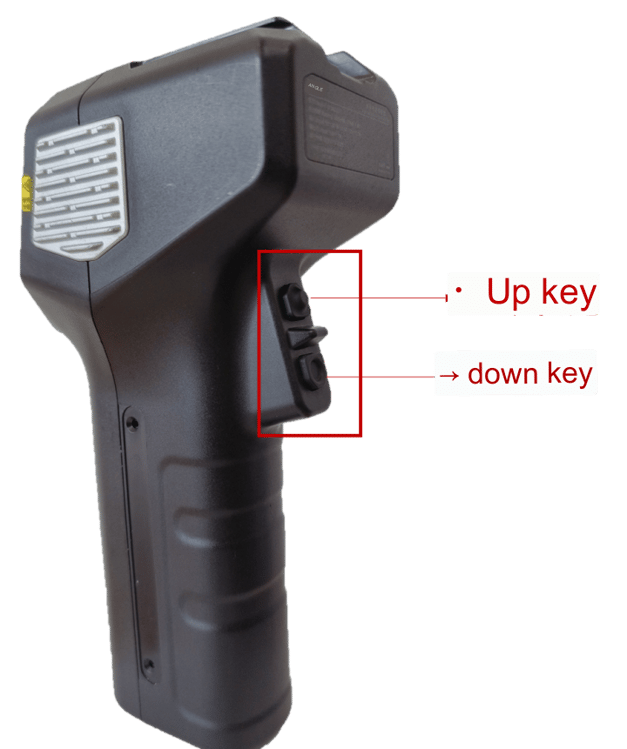The first thing to do before flying is to do a safety check, let's take a look at the following examples:
Zhang, a professional pilot in a village in Liuzhou, Guangxi, took off directly without
checking whether the propeller screws were firmly installed when he was giving medicine to
his employer in the same village. During the flight, the propeller rotated at high speed and
flew out, and the drone crashed, causing the liquid to flow directly into the field, causing the
employer's newly cultivated corn to suffer from the drug. Zhang not only needs to repair the
unmanned aircraft, but also has to compensate the employer for economic losses.
In fact, many safety accidents can be avoided, let's take a look at the following three things
you must do before flying.
First, the three elements of environmental inspection
The weather is safe
Check the weather conditions in advance before working, and choose to work in clear weather and wind speeds less than level 3. Due to strong wind or rainy operations, pesticides are easily blown away or diluted, and are not easy to remain on the leaf surface of crops, affecting the final plant protection effect.

Safety at take-off and landing points
- The take-off and landing point should be open and flat, if it is uneven, it will easily lead to unstable landing of the unmanned aircraft, tilting and falling to the ground and causing equipment damage;
- Make sure that there is no debris around the take-off and landing point, otherwise the wind farm will roll debris into the propeller during takeoff and landing, resulting in the bomber;
- Ensure that there are no obstacles above the take-off and landing point, otherwise it is easy to collide with obstacles during take-off and landing, resulting in impact accidents;
- Before takeoff, ensure that personnel are more than 10 meters away from the take-off and landing point to ensure the safety of personnel operation.
Safety of the flight operation area
- Before the operation, check whether the obstacles in the flight area are clearly marked;
- During the operation, clear the operation area, and it is strictly forbidden to have irrelevant personnel and equipment that interferes with the safety of the operation;
- When controlling the unmanned aircraft, maintain a high degree of concentration, and prohibit unrelated personnel from disturbing the operator's work;
- Make sure there are no steep slopes in the flight area that are greater than the ground elevation.
Second, the appearance inspection is three steps
You can follow the order of "top to bottom, left to right", and follow the three steps of "take a look, shake and turn" for visual inspection.
Take a look and keep it clean
.png?width=688&height=386&name=%E7%87%83%E6%B2%B9%E8%B6%85%E5%85%85%E6%95%85%E9%9A%9C%E7%BB%B4%E4%BF%AE%E6%B5%81%E7%A8%8B%E5%9B%BE.pdf%20(12).png)
The following parts need to be noted:
- Propeller: keep the surface clean and free of adhesion, check whether there are no cracks and no gaps;
- Top view radar/swing radar: keep the surface clean and free of adhesions, otherwise it will interfere with flight obstacle avoidance;
- Geo-imitation radar / PSL pilot view / downward view FPV view view image: Keep the lens surface clean. If it is dirty, please use a soft cloth to wipe it clean in one direction;
- Battery tail frame tail insert: the metal copper sheet appears black, green, you can use a cotton swab dipped in alcohol for cleaning, otherwise it will affect the battery power supply; 5) ESC: keep the surface clean and free of adhesions, otherwise it will affect the ESC heat dissipation;
- Battery: the appearance is clean without deformation, the gap between the battery cell is not filled by debris, and the interface with the battery tail frame is firmly connected installation;
- Arm folding parts: check that the folding parts are not deformed and cracked, and home page that the arm hoop is stable and not loose;
- Body structure: the overall structure is stable and no deformation.
- Centrifugal nozzle: check the appearance of the nozzle without foreign matter and no jamming.
Shake it, the structure is stable
Vibration during flight, coupled with long-term operation, may cause the screws of the motor base, arm, paddle clamp, battery tail frame, propeller, RTK antenna, data transmission antenna to loosen, if there is loose, please tighten the screws of the relevant structure to ensure that the body structure is stable before take-off operation, if cracks occur, please replace the relevant structures in time before operation.
Take a turn without stuttering
Motor: ensure that the motor rotates without stuttering, no abnormal noise, if there is abnormal noise jamming, it means that there are foreign objects in the motor that will affect flight safety, resulting in equipment bombing, you can try to clean up with a soft brush or hair dryer,
Spray plate: ensure no jamming and no damage, otherwise it will lead to uneven atomization particles. If you find an abnormality, please replace the spray plate in time.
For the above inspection methods have you mastered, we left you a visual inspection comparison table at the end of the course, you can check against the inspection, not afraid of missing the inspection.
Third, the six major systems look at one by one:
Each firmware update will fix bugs and vulnerabilities in older versions, bringing performance improvements and stability to the device to work in a better state. So make sure all firmware is upgraded to the latest version before each flight.
Step 1: Firmware update
1. First open the "XAG Agricultural Service" App, click "My" --- "Equipment" in the lower right corner of the homepage, select the unmanned aircraft that needs to be operated, and enter the "Equipment Details" interface;
2. Click the first icon at the top of the app interface "![]() " Enter the "General" interface, click "Firmware Update" to see whether the module firmware is the latest, if not updated, please upgrade to the latest version, each new firmware is an update to fix the previous version BUG and new features, so you should ensure that the firmware upgrade is the latest before each flight.
" Enter the "General" interface, click "Firmware Update" to see whether the module firmware is the latest, if not updated, please upgrade to the latest version, each new firmware is an update to fix the previous version BUG and new features, so you should ensure that the firmware upgrade is the latest before each flight.
.png?width=383&height=750&name=%E7%87%83%E6%B2%B9%E8%B6%85%E5%85%85%E6%95%85%E9%9A%9C%E7%BB%B4%E4%BF%AE%E6%B5%81%E7%A8%8B%E5%9B%BE.pdf%20(14).png)
Step 2: Communication system check
click the second icon in the taskbar at the top of the app "![]() Enter the "Communication System" interface, Check whether the communication signal is good and the display is normal. If the current network signal strength is poor, you can click "Carrier Settings" to switch the carrier network.
Enter the "Communication System" interface, Check whether the communication signal is good and the display is normal. If the current network signal strength is poor, you can click "Carrier Settings" to switch the carrier network..png?width=383&height=750&name=%E7%87%83%E6%B2%B9%E8%B6%85%E5%85%85%E6%95%85%E9%9A%9C%E7%BB%B4%E4%BF%AE%E6%B5%81%E7%A8%8B%E5%9B%BE.pdf%20(15).png)
Step 3: Positioning system check
click the third icon in the taskbar at the top of the app" ![]() " , enter the "Positioning System" interface.
" , enter the "Positioning System" interface.
Check whether the RTK base station is connected, whether the RTK positioning is normal, the number of connected satellites needs to be maintained at least 16, the positioning accuracy needs to be within 1 meter, and the heading accuracy needs to be kept within 2 degrees is normal, if it is not normal, you need to turn off the power of the unmanned aircraft to try to move the position, Or use webless mapping/operations.
.png?width=383&height=750&name=%E7%87%83%E6%B2%B9%E8%B6%85%E5%85%85%E6%95%85%E9%9A%9C%E7%BB%B4%E4%BF%AE%E6%B5%81%E7%A8%8B%E5%9B%BE.pdf%20(16).png)
Step 4: Battery system inspection
click The fourth icon in the taskbar at the top of the app"![]() "to enter the "Battery System"
"to enter the "Battery System"
interface.
First of all, you need to confirm whether the total remaining battery power is sufficient; Then click the "Cell Voltage" button to check whether the cell voltage is normal, if the current is greater than 20A after booting, it is not allowed to take off.
⚠️ Note: If it is a dual-battery operation flight, the voltage difference is too large, one battery will not be turned on, and the low-voltage battery needs to be charged and then used.
.png?width=383&height=750&name=%E7%87%83%E6%B2%B9%E8%B6%85%E5%85%85%E6%95%85%E9%9A%9C%E7%BB%B4%E4%BF%AE%E6%B5%81%E7%A8%8B%E5%9B%BE.pdf%20(17).png)
Step 5: Perform a system check
(i) Inspection of the spraying system
When the drone was mounted"Spray System", click the fifth icon in the taskbar at the top of
the app" ![]() will enter the "Spray System" interface.
will enter the "Spray System" interface.
Click the "Manual Spray Test" - "Open" button to test, check whether the spray plate rotates normally, ensure that the liquid flowing out is free of bubbles, and click "Close" to end the test after determining that the spraying system is normal.
(ii) Spreading system inspection
When the drone was mounted"Ruibo System", click the fifth icon in the taskbar at the top of the app" ![]() Enter the "Spreading System" screen.
Enter the "Spreading System" screen.
Click "Manual Spreading Test" to enter the test interface, click the "Open" button to test the "Discharger" and "Broadcast Tray", and click "Close" to end the test after confirming the normal discharge of the spreading system.
Step 6: Power system inspection
click The sixth icon in the taskbar at the top of the app"![]() Enter the power system interface and check the "power motor" and "tilting servo" in order.
Enter the power system interface and check the "power motor" and "tilting servo" in order.
(i) "Idle test" inspection:
On the "Power System" interface, click "Idle Test", according to the test value displayed by the system, confirm whether the motor steering is normal, whether the motor has abnormal noise, and if it is abnormal, takeoff operation is prohibited.
⚠️ Note:
1. The motor current value should not exceed 4A, the difference in the speed of the motor on the ground should not exceed 50 revolutions, and the air speed should not exceed 200 revolutions, if there is any abnormality, please repair it in time to ensure the normal operation of the motor;
2. The M100 and M1 propellers of the XAG P3 Pro agricultural unmanned aircraft rotate clockwise, and the M2 and M4 propellers rotate counterclockwise.
3. The M50 power motor of the XAG V1 Pro agricultural drone rotates clockwise and the M2 power motor rotates counterclockwise.png?width=383&height=750&name=%E7%87%83%E6%B2%B9%E8%B6%85%E5%85%85%E6%95%85%E9%9A%9C%E7%BB%B4%E4%BF%AE%E6%B5%81%E7%A8%8B%E5%9B%BE.pdf%20(18).png)
Step 7: Perceptual System Check
1. Tap the seventh icon in the taskbar at the top of the app" ![]() You can enter the "perception system" interface, and press the one-handed up and down buttons at the same time to let the unmanned aircraft take off and hover into the air to test whether the terrain module and obstacle avoidance radar are normal.
You can enter the "perception system" interface, and press the one-handed up and down buttons at the same time to let the unmanned aircraft take off and hover into the air to test whether the terrain module and obstacle avoidance radar are normal.

2. If you can see that the icon of each module is black on the app, it is normal..png?width=383&height=750&name=%E7%87%83%E6%B2%B9%E8%B6%85%E5%85%85%E6%95%85%E9%9A%9C%E7%BB%B4%E4%BF%AE%E6%B5%81%E7%A8%8B%E5%9B%BE.pdf%20(19).png)
This lesson passes three major pre-flight checks: the selection of the environment to the appearance inspection of the fuselage structure, and then to Whether the seven system parameters of the app are normal, whether the firmware is updated in time, etc., so as to ensure the safety of each flight operation. You are welcome to share your experience and experience in the message area, and you are also welcome to share this course with your pilot friends, so that everyone can pay attention to the safe operation of unmanned aircraft.
.png?height=120&name=Pegasus%20Robotics%20Logo%20-%20Portait%20(2).png)